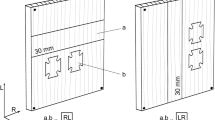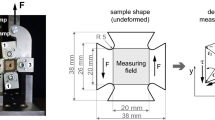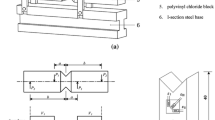Abstract
Several studies have dealt with the problem of how to measure the shear modulus of small clear wood specimens, avoiding bias from normal compression, bending, tension or torsional stresses. Unbiased results can be used to estimate realistic shear modulus values relevant for timber construction. However, a stress field that contains only uniformly distributed shear stress cannot be achieved. The Arcan shear test is one of the test setups that allows the measurement of more or less homogeneous shear stress and, therefore, shear deformation in a small volume of the specimen at macroscopic material level. The shear deformation of Arcan shear test samples was measured between the two notches by means of electronic speckle pattern interferometry (ESPI). Shear tests were performed in a tension mode, which provided a homogeneous strain field in the reduced midsection. Twisting forces and inhomogeneous shear deformation of the sample volume were assumed, which resulted in different shear deformation on the front and back sides of the sample. In this way, both surfaces of the samples were measured in parallel. Using the mean value of both deformation fields allowed a significant reduction in the coefficient of variation of shear modulus measurements to be achieved in comparison with values gained from a single ESPI measurement.






Similar content being viewed by others
References
American Society of Testing and Materials (1992a) Standard methods of testing small clear specimens of timber. ASTM D-143-83, vol 04.09. Wood ASTM, West Conshokocken, PA
American Society of Testing and Materials (1992b) Standard test methods for evaluating properties of wood-base fiber and particle panel materials. ASTM D 1037-91, vol 04.09. ASTM, West Conshokocken, PA
An W, Carlsson TE (2003) Speckle interferometry for measurement of continuous deformations. Opt Lasers Eng 40:529–541
Arcan M (1984) The Iosipescu shear test as applied to composite materials—discussion. Exp Mech 24(1):66–67
Arcan M, Hashin Z, Voloshin A (1978) A method to produce uniform plane-stress states with applications to fiber-reinforced materials. Exp Mech 18(4):141–146
Askenazi AK (1976) Anisotropy of wood and wood-base materials, 1st edn. Izdatelstvo Lesnaja Promuslennosty, Moscow (in Russian)
Beer RJ, Vanek M, Walden HD (1990) Zuverlässigkeit einer DMS-Meßstelle auf Holz, Kurzzeitstabilität-Langzeitverhalten. Holzforschung u Holzverwertung 42(3):48–51
Bergander A (2001) Local variability in chemical and physical properties of spruce wood fiber. Doctoral thesis, Royal Institute of Technology, Department of Pulp and Paper Chemistry and Technology, Stockholm, Sweden
Bodig J, Jayne BA (1982) Mechanics of wood and wood composites. Van Nostrand Reinhold Company Inc, New York
Côté WA (1981) Ultrastructure. Critical domain for wood behavior. Wood Sci Technol 15(1):1–29
Dahl KB, Malo KA (2009) Linear shear properties of spruce softwood. Wood Sci Technol 43:499–525
Dantec Ettemeyer (2001) ISTRA for Windows, Version 3.3.12. Dantec Ettemeyer GmbH, Ulm, Germany
De Magistris F, Salmén L (2005) Combined shear and compression analysis using a modified Iosipescu shear test device. Experimental studies on dry wood. Holzforschung 59:539–545
Dinwoodie JM (1975) Timber—a review of the structure–mechanical property relationship. J Microsc 104:3–32
Eberhardsteiner J (1995) Biaxial testing of orthotropic materials using electronic speckle pattern interferometry. Measurement 16(3):139–148
Eberhardsteiner J (2002) Mechanisches Verhalten von Fichtenholz – Experimentelle Bestimmung der biaxialen Festigkeitseigenschaften (Mechanical behaviour of spruce wood: experimental determination of biaxial strength properties). Springer, Vienna (in German)
CEN (2004) EN 789: Timber structures–Test methods–Determination of mechanical properties of wood based panels. European Committee for Standardization
Gerthsen C, Kneser HO, Vogel H (1986) Physik. Springer, Berlin, pp 504–508
Kollmann FP, Côté WA (1968) Principles of wood science and technology. Springer, Berlin
Lang EM (1997) An alternative method for shear strength assessment. For Prod J 47(11/12):81–84
Lichtenegger H, Reiterer A, Stanzl-Tschegg SE, Fratzl P (1999) Variation of cellulose microfibril angles in soft-woods and hardwoods: a possible strategy of mechanical optimization. J Struct Biol 128:257–269
Liu JY (1984) New shear strength test for solid wood. Wood Fiber Sci 8(4):252–261
Liu JY (2002) Analysis of off-axis tension test of wood specimens. Wood Fiber Sci 34:205–211
Liu JY, Floeter LH (1984) Shear strength in principal plane of wood. J Eng Mech 110(6):930–936
Liu JY, Dwight D, Flach R, Ross J, Lichtenberg GJ (1999) An improved shear test fixture using the Iosipescu specimen. In: Perkins R (ed) Mechanics of cellulosic materials 1999. Proceedings of the 1999 ASME joint applied mechanics and materials division meeting, June 27–30, 1999, Blacksburg, Virginia, USA. The American Society of Mechanical Engineers, Three Park Avenue, New York, NY 10016
Mohan NK, Rastogi P (2003) Recent developments in digital speckle pattern interferometry. Opt Lasers Eng 40(5–6):439–445
Müller U, Sretenovic A, Gindl W, Grabner M, Wimmer R, Teischinger A (2004a) Effects of macro-and micro-structural variability on the shear behaviour of softwood. IAWA J 25:231–243
Müller U, Sretenovic A, Gindl W, Teischinger A (2004b) Longitudinal shear properties of European larch wood related to cell-wall structure. Wood Fiber Sci 36(2):143–151
Müller U, Sretenovic A, Vincenti A, Gindl W (2005) Direct measurement of strain distribution along a wood bond line—part I: shear strain concentration in a lap joint specimen by means of electronic speckle pattern interferometry. Holzforschung 59:300–306
Persson K (2000) Micromechanical modelling of wood and fibre properties. Dissertation, Lund University, Lund, Sweden
Pierron F (1998) Saint-Venant effects in the Iosipescu specimen. J Compos Mater 32(22):1986–2015
Rastogi PK (2001) Measurement of static surface displacements, derivatives of displacements, and three-dimensional surface shapes—examples of applications to non-destructive testing. In: Rastogi PK (ed) Digital speckle pattern interferometry and related techniques. Wiley, Chichester, pp 141–224
Siebert T, El-Ratal W, Wegner R, Ettemeyer A (2002) Combined simulation and experiment in automotive testing with ESPI measurement. Exp Tech 26(3):42–47
Silker A (1971) Resistance strain gages and adhesives for wood. For Prod J 21(12):40–41
Sretenovic A, Müller U, Gindl W, Teischinger A (2004) New shear assay for the simultaneous determination of shear strength and shear modulus in solid wood: finite element modelling and experimental results. Wood Fiber Sci 36(3):302–310
Szalai J (1992) Indirect determination of shearing strength of wood using the anisotropic strength theory. Holz Roh- Werkst 50:233–238 (in German)
R Core Team (2012) R: a language and environment for statistical computing. R Foundation for Statistical Computing, Vienna, Austria, http://www.R-project.org/. ISBN: 3-900051-07-0
Wang P, Pierron F, Thomsen T (2013) Identification of material parameters of PVC foams using digital image correlation and the virtual fields method. Exp Mech 53:1001–1015
Xavier JC, Garrido NM, Oliveira M, Morais JL, Camanho PP, Pierron F (2004) A comparison between the Iosipescu and off-axis shear test methods for the characterization of Pinus Pinaster Ait. Compos A Appl Sci Manuf 35(7–8):827–840
Xavier J, Avril S, Pierron F, Morais J (2007) Novel experimental approach for longitudinal-radial stiffness characterisation of clear wood by a single test. Holzforschung 61:573–581
Xavier J, Oliveira M, Morais J, Pinto T (2009a) Measurement of the shear properties of clear wood by the Arcan test. Holzforschung 63:217–225
Xavier J, Avril S, Pierron F, Morais J (2009b) Variation of transverse and shear stiffness properties of wood in a tree. Compos A 40:1953–1960
Ylinen A (1963) A comparative study of different types of shear tests of wood. Paper presented at the fifth conference of wood technology, USDA Forest Service, Forest Products Laboratory, Madison, WI
Acknowledgments
We thank all persons involved in the research project that led to this contribution, especially Bernd Heissenberger for preparing the test specimen, David Kaserer and Markus Tripolt for supporting the experimental program, and Prof. Josef Eberhardsteiner from Vienna University of Technology for providing access to one of the two ESPI systems.
Author information
Authors and Affiliations
Corresponding author
Rights and permissions
About this article
Cite this article
Müller, U., Ringhofer, A., Brandner, R. et al. Homogeneous shear stress field of wood in an Arcan shear test configuration measured by means of electronic speckle pattern interferometry: description of the test setup. Wood Sci Technol 49, 1123–1136 (2015). https://doi.org/10.1007/s00226-015-0755-3
Received:
Published:
Issue Date:
DOI: https://doi.org/10.1007/s00226-015-0755-3




